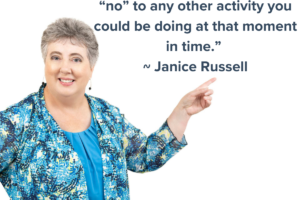
Top 10 Ways to Say “No”
Friend: “Do you want to jump off that bridge?” You: “No!” (at least not without a bungee cord)
Colleague: “Will you work 24/7 for a week straight?”You: “No!”
Friend: “Want to walk from New York to California?”You: “No!” (unless your an ultra athlete or passionate about a cause)
Colleague: “You need to take a 50% pay cut.”You: “No!”
Sometimes it is obvious and easy to say “no.” Other times, this short word is one of the hardest to say. Yet when you don’t say “no” to some tasks, you end up feeling overwhelmed.
What can be done? Learn to say “no!” It takes practice. It’s especially hard when the request is something you’d like to do but are unable to due to time constraints. Here are some practice statements:
To an event you don’t want to attend or to a volunteer opportunity
- “My schedule is totally full right now, I’m sorry.” You don’t have to say what it is full with.
- “While I’d love to help out, my calendar doesn’t have any openings right now. ” Don’t elaborate.
- “It sounds like a great event, but I’m not open at that time.” This can be said even if the time is “booked” as personal time.
- “I appreciate your confidence in my abilities, while I’m not able to make the time commitment for <x>, I can help with <task that takes less time.>”
- “I’m not able to make new time commitments, have you checked with Sue?”

In a professional capacity
- “Jane already has me working on Project LMN. We can talk with her to see if the schedule can be changed or you and I can look for an alternative deadline.”
- “While I have some experience in that area, it isn’t where my skills are best utilized.” Turning down a less-than-ideal client.
- “Thank you for having confidence in me. I’d really like to get additional training before I take on such a task.”
- “That sounds like a great project but my time is spoken for until Project FGH is finished.” Don’t elaborate.
- “I really enjoyed the office party last year, unfortunately that time is already booked on my calendar.” This can be said even if the time is “booked” as personal time.
Notice that none of the statements starts with “no.” That’s because the minute you say “no” the other person starts thinking of all the ways to persuade you to say “yes.” Instead, you declined the opportunity by giving a short statement with one reason you won’t be able to say “yes.”
3 More Strategies:
-
Stand Your Ground. The person will be persuasive. Don’t argue, just restate your initial response. After a couple of minutes, make a graceful exit.
- Toss the guilt. You may have scheduled a nap or massage or nothing at all. The “why” doesn’t matter; you’re just not available. Preserving “me” time (and your sanity) is important. Don’t be guilted into saying “yes.”
- Practice, Practice, Practice. You need to create and practice several “no” statements which feel comfortable to you. At the very least, have one generic answer like, “I need to check my schedule. I’ll get back to you in a couple of days.” If they need to know immediately, respond: “I’m not able to give an answer right now, so I’ll have to decline.”
Now, to wrap things up, I’d like to share a my favorite quote from Anne Lamont:
“’No’ is a complete sentence.”
If this quote doesn’t convince you to say “no” more frequently, then nothing will. And that’s why I encourage you to take what you’ve learned in this post and use it to be like Anne Lamont. Because no matter who you are, you too can manage your schedule more easily by employing your “no” more frequently!
Tag:ADHD, Anne Lamont, anxiety, autoimmune disease, brain based disorders, depression, Feeling Overwhelmed, Janice Russell, Learn to Say No, life transitions, Life Transitions Organizing, Life Transitions Resources, life-disrupting situation, Manage Your Schedule, productivity and organizing professional, professional organizer, TBI, Time Constraints, Transition Success Program



